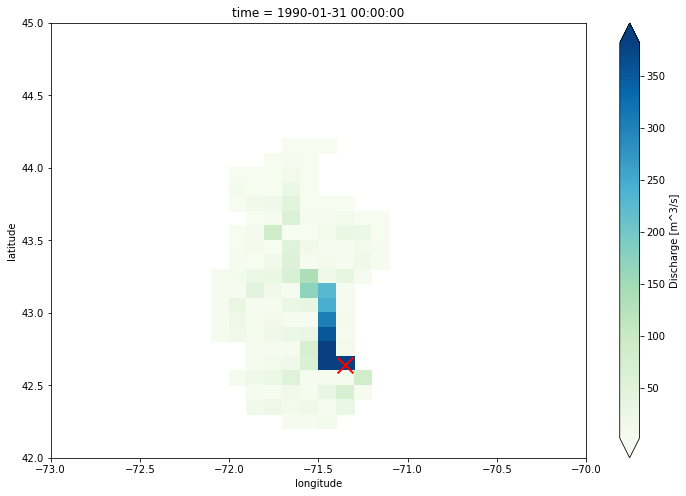
Running LISFLOOD model using eWaterCycle package (on SURF Research Cloud)
This notebooks shows how to run LISFLOOD model. Please note that the lisflood-grpc4bmi docker image in eWaterCycle is compatible only with forcing data and parameter set on eWaterCycle infrastructure like a server on the SURF Research Cloud. More information about data, configuration and installation instructions can be found in the System setup in the eWaterCycle documentation.
1 In:
import logging
import warnings
logger = logging.getLogger("grpc4bmi")
logger.setLevel(logging.WARNING)
warnings.filterwarnings("ignore", category=UserWarning)
2 In:
import pandas as pd
import ewatercycle.forcing
import ewatercycle.models
import ewatercycle.parameter_sets
Load forcing data
For this example notebook, lisflood_ERA-Interim_*_1990_1990.nc data are copied from /projects/0/wtrcycle/comparison/forcing/lisflood to /scratch/shared/ewatercycle/lisflood_example/lisflood_forcing_data. Also the lisvap output files ‘e0’, ‘es0’ and ‘et0’ are generated and stored in the same directory. These data are made by running ESMValTool recipe and lisvap. We can now use those files to run the Lisflood model.
3 In:
forcing = ewatercycle.forcing.load_foreign(
target_model="lisflood",
directory="/mnt/data/forcing/lisflood_ERA5_1990_global-masked",
start_time="1990-01-01T00:00:00Z",
end_time="1990-12-31T00:00:00Z",
forcing_info={
"PrefixPrecipitation": "lisflood_ERA5_pr_1990_1990.nc",
"PrefixTavg": "lisflood_ERA5_tas_1990_1990.nc",
"PrefixE0": "lisflood_ERA5_e0_1990_1990.nc",
"PrefixES0": "lisflood_ERA5_es0_1990_1990.nc",
"PrefixET0": "lisflood_ERA5_et0_1990_1990.nc",
},
)
print(forcing)
eWaterCycle forcing
-------------------
start_time=1990-01-01T00:00:00Z
end_time=1990-12-31T00:00:00Z
directory=/mnt/data/forcing/lisflood_ERA5_1990_global-masked
shape=None
PrefixPrecipitation=lisflood_ERA5_pr_1990_1990.nc
PrefixTavg=lisflood_ERA5_tas_1990_1990.nc
PrefixE0=lisflood_ERA5_e0_1990_1990.nc
PrefixES0=lisflood_ERA5_es0_1990_1990.nc
PrefixET0=lisflood_ERA5_et0_1990_1990.nc
Load parameter set
This example uses parameter set from SURF dCache storage.
4 In:
parameterset = ewatercycle.parameter_sets.ParameterSet(
name="Lisflood01degree_masked",
directory="/mnt/data/parameter-sets/lisflood_global-masked_01degree",
config="/mnt/data/parameter-sets/lisflood_global-masked_01degree/settings_lisflood_ERA5.xml",
target_model="lisflood",
)
print(parameterset)
Parameter set
-------------
name=Lisflood01degree_masked
directory=/mnt/data/parameter-sets/lisflood_global-masked_01degree
config=/mnt/data/parameter-sets/lisflood_global-masked_01degree/settings_lisflood_ERA5.xml
doi=N/A
target_model=lisflood
supported_model_versions=set()
Set up the model
To create the model object, we need to select a version.
5 In:
ewatercycle.models.Lisflood.available_versions
5 Out:
('20.10',)
6 In:
model = ewatercycle.models.Lisflood(
version="20.10", parameter_set=parameterset, forcing=forcing
)
print(model)
Model version 20.10 is not explicitly listed in the supported model versions of this parameter set. This can lead to compatibility issues.
eWaterCycle Lisflood
-------------------
Version = 20.10
Parameter set =
Parameter set
-------------
name=Lisflood01degree_masked
directory=/mnt/data/parameter-sets/lisflood_global-masked_01degree
config=/mnt/data/parameter-sets/lisflood_global-masked_01degree/settings_lisflood_ERA5.xml
doi=N/A
target_model=lisflood
supported_model_versions=set()
Forcing =
eWaterCycle forcing
-------------------
start_time=1990-01-01T00:00:00Z
end_time=1990-12-31T00:00:00Z
directory=/mnt/data/forcing/lisflood_ERA5_1990_global-masked
shape=None
PrefixPrecipitation=lisflood_ERA5_pr_1990_1990.nc
PrefixTavg=lisflood_ERA5_tas_1990_1990.nc
PrefixE0=lisflood_ERA5_e0_1990_1990.nc
PrefixES0=lisflood_ERA5_es0_1990_1990.nc
PrefixET0=lisflood_ERA5_et0_1990_1990.nc
7 In:
model.parameters
7 Out:
[('IrrigationEfficiency', '0.75'),
('MaskMap', '/data/input/areamaps/model_mask'),
('start_time', '1990-01-01T00:00:00Z'),
('end_time', '1990-12-31T00:00:00Z')]
Setup model with model_mask, IrrigationEfficiency of 0.8 instead of 0.75 and an earlier end time, making total model time just 1 month.
8 In:
model_mask = "/mnt/data/climate-data/aux/LISFLOOD/model_mask.nc"
config_file, config_dir = model.setup(
IrrigationEfficiency="0.8", end_time="1990-1-31T00:00:00Z", MaskMap=model_mask
)
print(config_file)
print(config_dir)
Running /mnt/data/singularity-images/ewatercycle-lisflood-grpc4bmi_20.10.sif singularity container on port 41619
/home/vagrant/ewatercycle/docs/examples/ewatercycle_output/lisflood_20210930_093520/lisflood_setting.xml
/home/vagrant/ewatercycle/docs/examples/ewatercycle_output/lisflood_20210930_093520
9 In:
model.parameters
9 Out:
[('IrrigationEfficiency', '0.8'),
('MaskMap', '/mnt/data/climate-data/aux/LISFLOOD/model_mask'),
('start_time', '1990-01-01T00:00:00Z'),
('end_time', '1990-01-31T00:00:00Z')]
Initialize the model with the config file:
10 In:
model.initialize(config_file)
Get model variable names
11 In:
model.output_var_names
11 Out:
('Discharge',)
Run the model
Store simulated values at one target location until model end time. In this example, we use the coordinates of Merrimack observation station as the target coordinates.
12 In:
target_longitude = [-71.35]
target_latitude = [42.64]
target_discharge = []
time_range = []
end_time = model.end_time
while model.time < end_time:
model.update()
target_discharge.append(
model.get_value_at_coords(
"Discharge", lon=target_longitude, lat=target_latitude
)[0]
)
time_range.append(model.time_as_datetime.date())
print(model.time_as_isostr)
1990-01-03T00:00:00Z
1990-01-04T00:00:00Z
1990-01-05T00:00:00Z
1990-01-06T00:00:00Z
1990-01-07T00:00:00Z
1990-01-08T00:00:00Z
1990-01-09T00:00:00Z
1990-01-10T00:00:00Z
1990-01-11T00:00:00Z
1990-01-12T00:00:00Z
1990-01-13T00:00:00Z
1990-01-14T00:00:00Z
1990-01-15T00:00:00Z
1990-01-16T00:00:00Z
1990-01-17T00:00:00Z
1990-01-18T00:00:00Z
1990-01-19T00:00:00Z
1990-01-20T00:00:00Z
1990-01-21T00:00:00Z
1990-01-22T00:00:00Z
1990-01-23T00:00:00Z
1990-01-24T00:00:00Z
1990-01-25T00:00:00Z
1990-01-26T00:00:00Z
1990-01-27T00:00:00Z
1990-01-28T00:00:00Z
1990-01-29T00:00:00Z
1990-01-30T00:00:00Z
1990-01-31T00:00:00Z
Store simulated values for all locations of the model grid at end time.
13 In:
discharge = model.get_value_as_xarray("Discharge")
14 In:
model.finalize()
Inspect the results
The discharge time series at Merrimack observation station:
15 In:
simulated_target_discharge = pd.DataFrame(
{"simulation": target_discharge}, index=pd.to_datetime(time_range)
)
simulated_target_discharge.plot(figsize=(12, 8))
15 Out:
<AxesSubplot:>

The lisflood output has a global extent. In this example, we plot the discharge values in Merrimack catchment and at the last time step.
16 In:
lc = discharge.coords["longitude"]
la = discharge.coords["latitude"]
discharge_map = discharge.loc[
dict(longitude=lc[(lc > -73) & (lc < -70)], latitude=la[(la > 42) & (la < 45)])
].plot(robust=True, cmap="GnBu", figsize=(12, 8))
discharge_map.axes.scatter(
target_longitude, target_latitude, s=250, c="r", marker="x", lw=2
)
16 Out:
<matplotlib.collections.PathCollection at 0x7fa2c01215b0>

In: